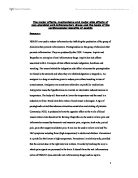Blood flow is best measured using an electromagnetic flow probe which provides a continuous measurement. This utilises the fact that blood is an electrolyte and so can carry electricity. Therefore, if it passes through a magnetic field it will generate a current, and the magnitude of this current is proportional to the velocity of the blood flow. If one assumes that the diameter of the blood vessel remains constant, then if the velocity of the blood increases the flow rate must have increased. One can justify this assumption by ensuring that the diameter cannot change by using a C-shaped probe that effectively "clamps" the vessel. The measurement of blood flow to the kidneys thus becomes easy to measure; one has simply to make sure that one is recording from the renal artery and one can assess the drug's effect upon kidney blood flow. To measure changes in the blood flow to the skeletal muscle is more complicated. It is best to measure blood flow in the femural artery since this has the highest ratio of blood going to skeletal muscle of any artery in the body. But one must bear in mind that a little of the blood is going to the skin and the bone. To increase the accuracy in a nonsurvival experiment one can remove the skin. If the drug is being assessed in a human the best one can do is cool the skin so as to decrease its blood flow. This is only advisable if one is not bothered about the potentially confusing effects of the skins reflex responses to cold. An alternative technique to measure blood flow is to use ultrasound, which measures the Doppler shift of the flowing blood.
Pulmonary vascular resistance is calculated by dividing the pressure gradient across the lungs by pulmonary blood flow. The latter, which is equivalent to cardiac output, can be measured using an electromagnetic probe placed around the ascending aorta. Unfortunately this technique is generally too invasive to use on humans, and thus one must settle for a discontinuous measurement. The best method is thermodilution, whereby cold saline is injected into the right atrium through one side of a double-lumen catheter, and the temperature change is recorded in the pulmonary artery using a thermistor in the other, longer side of the catheter. The temperature change is inversely proportionate to the amount of blood flowing through the pulmonary artery, ie. to the extent that the cold saline is diluted by the blood. This technique has two important advantages; first, the cold is dissipated in the tissues so that recirculation is not a problem, and secondly the saline is completely innocuous, so it is easy to make repeated determinations. However, one must ensure that repeated measurements take place at the same stage of the respiratory cycle since this affects cardiac output by altering intrathoracic pressure. The pulmonary pressure gradient is equal to the pulmonary arterial pressure minus the pulmonary venous pressure (equivalent to left atrial pressure). These two values are measured using a cannula attached to a strain gauge manometer. However, inserting a cannula directly into the pulmonary artery would be too invasive, involving the opening up of the chest cavity. Thus a catheter with a balloon attached is inserted into the femural artery. The balloon causes the catheter to float in the blood, and it is carried around the blood system, through the right atrium and right ventricle and on into the pulmonary artery. It eventually gets wedged in a smaller pulmonary artery, and blocks blood flow. The pressure then falls until it equals the pressure in the left atrium which can then be recorded. The balloon is then deflated and pulmonary artery pressure can be recorded. In this way pulmonary vascular resistance can be calculated.
Psychology and Neuroscience







